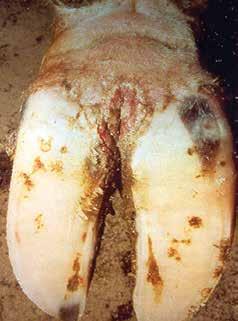
4 minute read
Focus on Herd Health
Strawberry Foot Rot Lameness in Feedlot Cattle
By Daniel Pecoskie, DVM, Metzger Veterinary Services
Strawberry foot rot, also known as digital dermatitis or hairy heel wart, is a disease of growing concern in finisher feedlot cattle in Canada and the United States. It is a bacterial foot infection caused by a Treponema bacteria species. Treponema is very commonly found in strawberry foot rot wounds; however, the disease does seem to have multiple bacterial species involved. It has been prevalent in the dairy industry for many years, and can be managed with preventive treatments and early intervention.
Strawberry foot rot causes clinical signs ranging from scabs or erosions on the heel, to mild or even clinical lameness. Strawberry foot rot appears as small red, raised lesions that may appear bloody. They are often one to four centimeters in size. The abrasions are usually found on the heel bulb of the hoof, and are commonly seen on the feet of the hind limbs, though they can affect the front hooves as well. They may also cause similar lesions near the front of the hoof, where the hoof and skin meet. The foot typically does not swell as with regular foot rot lesions, but the foot can be very painful and the animal may be nonweightbearing.

The bacterial species involved in strawberry foot rot survive well in wet, muddy conditions or in deep manure. They can be passed from animal to animal through contaminated pens. As the disease takes time to progress, it is thought that it may be carried into the feedlot on a few animals with minor lesions that can then contaminate the pen and affect an entire group over time. It can be very difficult to control, especially in feedlots that are continually filled with cattle. Due to the gradual progression of the foot lesions, it is often finisher animals that present with significant lameness.
Lame finisher cattle are a major economic concern in the feedlot, as they tend not to eat as well and do not grow as fast as healthy cattle. Strawberry foot rot can cause progressive lameness in finisher animals, which may require that affected animals be shipped before the lameness progresses to a non-weightbearing stage. Affected animals may need to be shipped as lightweight cattle.

Lame cattle can be treated with moderate success, as the heel lesions are usually responsive to topical antibiotics placed directly on the wounds. Some methods of control can be difficult to implement in a feedlot setting. Antibiotic or copper sulfate footbaths have shown to prevent or control minor lesions on the foot, but coordinating safe and efficient movement of feedlot cattle through a footbath takes some planning. Frequent cleaning of pens, and application of lime to empty pens between groups of cattle can help to decrease the bacterial load in the pen. The most common treatment is topical application of tetracycline to the wound, either as a paste or spray, or as a powder held on to heel by bandage. The other main concern with treating finisher cattle is the meat withdrawal. Topical treatment with antibiotics will not typically increase the slaughter withdrawal, but contact your vet before treating large numbers of animals. Injectable antibiotics do not typically have very much success in improving strawberry foot rot lesions, unless the affected foot or leg has also begun to swell. The bacteria are responsive to antibiotics, but injectable antibiotics in circulation do not reach high enough levels in the skin to resolve the issue. Direct contact of the antibiotic to the wound is the most effective treatment method.
In the case of group outbreaks of strawberry foot rot lameness in the finisher pen, feedlot owners may choose to implement any of the control measures discussed above. If isolated to a single pen, care should be made to prevent mixing of affected and non-affected cattle. This will help reduce the spread of the bacteria to younger, growing animals that will not start to show signs of disease for several months. Other than contaminated home pens, care should be made to reduce contamination of hospital pens and use of dirty hoof trimming equipment. Any exposure to contaminated bedding and manure can lead to spread to non-affected cattle. If you suspect you may be dealing with lameness associated with strawberry foot rot, contact your vet for more information and the implement a farm-specific approach for disease control. OB
1. Sullivan, L. E., Carter, S. D., Blowey, R., Duncan, J. S., Grove-White, D., & Evans, N. J. (2013). Digital dermatitis in beef cattle. Veterinary Record
2. Plummer, P. J., & Krull, A. (2017). Clinical Perspectives of Digital Dermatitis in Dairy and Beef Cattle. Veterinary Clinics of North America: Food Animal Practice
3. Döpfer, D., Holzhauer, M., & Boven, M. van. (2012). The dynamics of digital dermatitis in populations of dairy cattle: Model-based estimates of transition rates and implications for control. The Veterinary Journal









